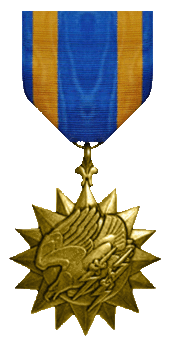Air Medal (USA)
The Air Medal may be awarded to recognize either single acts of merit or gallantry in combat or for meritorious service in a combat zone. Award of the Air Medal is primarily intended to recognize those personnel who are on current crew member or non-crew member flying status which requires them to participate in aerial flight on a regular and frequent basis in the performance of their primary duties. However, it may also be awarded to certain other individuals whose combat duties require regular and frequent flying in other than a passenger status, or individuals who perform a particularly noteworthy act while performing the function of a crew member but who are not on flying status. These individuals must make a discernible contribution to the operational land combat mission or to the mission of the aircraft in flight.
Examples of personnel whose combat duties require them to fly include those in the attack elements of units involved in air-land assaults against an armed enemy and those directly involved in airborne command and control of combat operations. Examples would be transport performing supporting "Dustoff" Medevac or resupply operations, or aircraft involved in reconnaissance over hostile airspace. Awards will not be made to individuals who use air transportation solely for the purpose of moving from point to point in a combat zone.
The Army may award the Air Medal for peacetime service, but approval authority is by general-grade officers at the group or brigade level or higher. The Air Force does not award the Air Medal for peacetime sustained operational activities and flights. Non-combat meritorious service is instead awarded the Aerial Achievement Medal, instituted in 1988.
Description
A 42-mm wide, bronze compass rose with 16 points, suspended by a pointer and charges with a diving American eagle with, facing left, with thunderbolts in its talons.
Ribbon
The blue ribbon is 35-mm wide with orange stripes (7-mm wide) situated 2-mm from each edge.
Ribbon devices
The Air Force uses the aircraft sortie designation as a tool, but uses Oak Leaf Clusters rather than Strike / Flight Numerals to indicate additional awards. A member's individual flight management records will list the sorties that are eligible for the award. These sorties are designated Combat, Combat Support, or Operational (Active Air Defense or Hostile Reconnaissance). Only the first sortie of the day counts. Armed aircraft crews require ten sorties for each award, while all others require twenty sorties.
Issued
There have been 10 Signals and C&E Branch recipients of the United States Air Medal. 3 members have earned a bronze oak leaf cluster denoting a subsequent award and 2 members have earned a second oak leaf cluster.
Please see Air Medal (USA) - Signals Recipients for a listing of the individuals.
